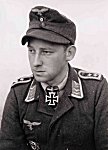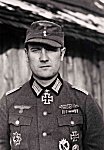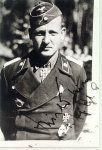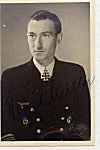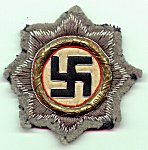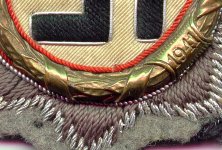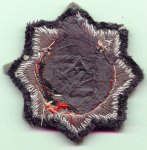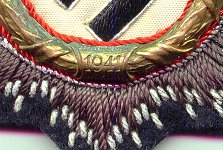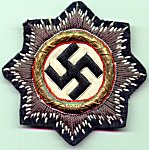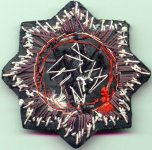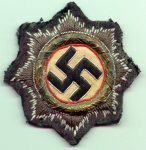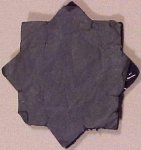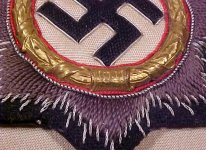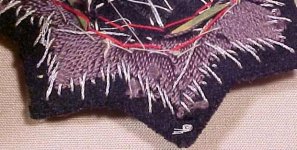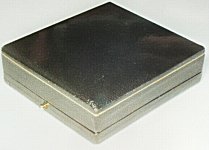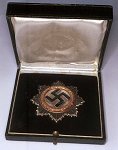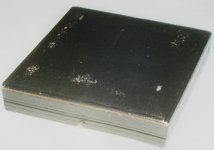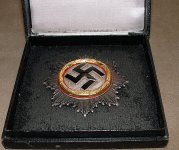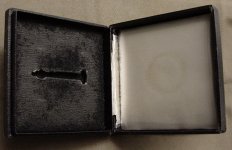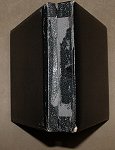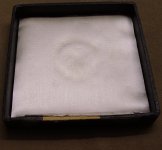
By François Saez and Jacques
Calero
The embroidered version in Gold
On 7 April 1943 (H.M.1943, S.211, 7 April 1943), the manufacture and wear of an embroidered version was authorized for combat wear, for certain specialties, with the object of avoiding snagging the Cross in the cramped fighting spaces. This method of wear concerned personnel of the
armored forces, submariners, and Luftwaffe air crews.
The Cross is entirely embroidered, with exception of the metal wreath (buntmetall) of a particularly detailed and well stamped type, resembling the DESCHLER type, with 4 prongs.
Two versions exist, differentiating themselves essentially by the quality of the white embroidery on which is embroidered the swastika.
Two manufacturers are known, and their marks were printed in white on the reverse of the decoration. These are JOSEF FEIX & SOHN (stamp ‘’JFS’’ ) and SCHAUERTE & HOHFELD (stamp ‘’SH ‘’).
A stamped mark has been observed (C.A. WESTMANN DRESDEN), but remains to be authenticated.
The border of the decoration is in colored wool : field gray for the Army and Waffen SS, black for Panzer troops, blue-gray for the Luftwaffe,
navy blue for the Kriegsmarine, and white backed one for summer wear. A khaki variant is supposed to have existed for the
Afrikakorps but to our knowledge there are no contemporary photos illustrating
that varietie.
The reverse of the Cross is covered by black protective paper. All the embroidery is in cotton, in silk and in
aluminum thread. They correspond with the colors of the metal model. It was delivered packed and protected by a cellophane packet.
Some measurements observed:
Model observed W: 71 mm / H: 73.3 mm / Weight: 7.85 gr. (LW)
Model observed W: 71 mm / H: 71 mm / Weight: 7.85 gr.(LW)
Model observed W: 70 mm / H: 72 mm / Weight: 7.29 gr.(KM)
Model observed W: 71.1 mm / H: 71.4 / Weight: 7.48 gr.(KM)
Model reported W: 71 mm / H: 71.2 / Weight: 7.3 gr.(Heer)
Other weight reported is 7.8 gr. (LW)
 |
 |
The embroidered version in Silver
Although initially the Silver version was thought not to be presented in gold, we have the proof that it was attributed - Below are the pictures from the uniform of General der Artillerie a.D. Franz Barckhausen (Chief of the Military Economic and Armaments Staff, Chief of the Primary Traffic Control, France and Belgium (from July 1942 to April 1943) Führer-Reserve, detached to Paris for Special Assignments until 20 July 1943. Retired on 1 August 1943). He was awarded the Deutsches Kreuz in Silber on 31 August 1943.
Cases
Like most decorations, the German Cross was presented in a case. There are four types. They are in either pressed cardboard or wood.
- The first is one which one might call the ‘’small model’’, corresponding to all the first Crosses attributed of the Deschler type with 10 or 6 rivets and a short pin. It is covered in black paper imitating leather. The bottom of the case, in which the Cross reposes is very convex. It measures 75.4mm by 83.0mm by 26.5mm high, and weighs 53 gr. The bottom lining is black plush. The interior of the lid is lined in white satin. A gilt or silvered stripe is painted around the top of the lid 3mm from the outer edges.
- The large format case is the most common model. It made its appearance in the summer of 1942. It too is covered in black leatherette, with a gilt or silvered stripe around the top of the lid. It measures 108mm by 108mm by 27mm high. It weighs 95-105gr empty. The bottom lining is lined with black flock (or velvet) , and the interior of the lid is lined in white satin. A gilt or silvered stripe is painted around the top of the lid 3mm from the edges.
- To these frequently encountered large format models, the authors would like to add a distinction encountered with cases accompanying the ‘’20’’ type, the so-called ‘’heavy model’’, whose characteristic remain the same, but change dimensions : the length is 112.6 mm, the width is 111.2 mm, the height is 24mm, with a weight of 104 gr.
- Finally, there exists what is called the ‘’end of the war’’ model or « half case »
(halbe etui), characterized by absence of a press- button closure and hinge.
![]()
© Copyright Wehrmacht-Awards.com LLC |
